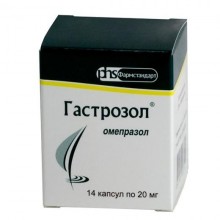



Gastrozole is anti-ulcer.
Inhibits H+K+ATPase (proton pump) in the parietal cells of the stomach and blocks the final stage of basal and stimulated secretion of hydrochloric acid.
Pharmacodynamics
It easily penetrates the cells of the gastric mucosa and has a cytoprotective effect. Reception at a dose of 20 mg maintains a pH value of up to 3 for 16 hours, lasts for 24 hours. It has an anti-helicobacter effect: it shows a bactericidal effect due to the accumulation of ammonium in the antrum of the stomach and increases the number of vegetative forms that are mainly affected by antibiotics in the fundic department .
Pharmacokinetics
Quickly and completely absorbed from the gastrointestinal tract (food intake does not affect the speed). Cmaxafter a single dose, 40 mg is achieved in 2–3 hours. In the blood, 95% binds to plasma proteins. Almost completely biotransformed in the liver and excreted in the urine as metabolites. T1/2 - 0.5–3 h.
Peptic ulcer and duodenal ulcer, incl. peptic ulcer associated with H. pylori, reflux esophagitis, Zollinger-Ellison syndrome, erosive and ulcerative lesions of the gastrointestinal tract caused by NSAIDs; acid suction prevention.
1 capsule contains:
Active substance: omeprazole 20 mg;
Excipients: mannitol, sucrose, sodium lauryl sulfate, sodium hydrogen phosphate (disodium phosphate disubstituted), calcium carbonate, lactose, hypromellose (hydroxypropylmethylcellulose), methacrylic acid and ethyl acrylate copolymer (methacrylic acid copolymer L30D), propylene glycol, and ethyl acetate, polyethyl acrylate (methacrylate acid copolymer L30D), propylene glycol, and ethyl acetate, polyethyl acetate, polyethyl acrylate (L30D methylacrylate acid copolymer, hydroxypropylmethyl cellulose), methylacrylate (tween-80), povidone (polyvinylpyrrolidone), titanium dioxide, talc;
The composition of the body and caps of the capsules: ferric oxide red (E172), titanium dioxide (E171), methyl parahydroxybenzoate (methylhydroxybenzoate), propyl parahydroxybenzoate (propyl hydroxybenzoate), gelatin; or iron oxide red (E172), titanium dioxide (E171), gelatin.
Omeprazole is marketed under different brands and generic names, and comes in different dosage forms:
| Brand name | Manufacturer | Country | Dosage form |
|---|---|---|---|
| Gastrosol | Pharmstandard | Russia | capsules |
| Omez | Dr. Reddy`s | India | capsules |
| Omeprazole-OBL | Obolensky OP | Russia | capsules |
| Omeprazole-Teva | Teva | Israel | capsules |
| Ortanol® | Sandoz | Switzerland | capsules |
| Omez | Dr. Reddy`s | India | powder |
| Omez | Dr. Reddy`s | India | lyophilisate |
| Ultop | Krka dd Novo mesto AO | Slovenia | bottle |
| Ultop | Krka dd Novo mesto AO | Slovenia | capsules |
| Omitox | Shreya | India | capsules |
| Losec MUPS® | AstraZeneca | UK | pills |
No customer reviews for the moment.
Orally, in the morning, on an empty stomach, without chewing and washing down with a small amount of liquid.
With the exacerbation of gastric ulcer and duodenal ulcer - 20 mg 1 time per day, if necessary, the dose can be increased to 40 mg 1 time per day. The duration of treatment varies from 4 (in patients with duodenal ulcer) to 8 weeks (in patients with gastric ulcer). In case of poor ulcer healing, it is recommended to prescribe the drug for another 4 weeks.
Forprevention of recurrence of gastric ulcer and duodenal ulcer - 20–40 mg (if necessary) 1 time per day.
Withreflux esophagitis - 20–40 mg once daily for 4–12 weeks.
WithZollinger-Ellison syndrome - the dose is set individually. The recommended initial dose is 60 mg once a day. A dose exceeding 80 mg / day should be divided into 2 doses (every 12 hours), a dose exceeding 120 mg should be divided into 3 doses.
Foracid suction prevention - 40 mg in the evening before surgery and 40 mg in 1-4 hours before the procedure.
Treatment of erosive and ulcerative lesions caused by taking NSAIDs - 20 mg 1 time per day for 4 weeks, if necessary, treatment can be continued for another 4 weeks. For the prevention of relapse, maintenance therapy at a dose of 20 mg is recommended.
Withpeptic ulcer associated with Helicobacter pylori There are several schemes of combination therapy ("triple" or "double"):
Patients with impaired liver function, the maximum daily dose is 20 mg.
From the nervous system and sense organs: dizziness, headache, agitation, depression.
Since the cardiovascular system and blood (hematopoiesis, hemostasis): leuco-, thrombocytopenia, agranulocytosis.
On the part of the digestive tract: dry mouth, nausea, vomiting, abdominal pain, flatulence, diarrhea or constipation, increased activity of hepatic transaminases.
From the musculoskeletal system: arthralgia, myalgia.
On the part of the skin: photosensitization, alopecia, erythema multiforme.
Allergic reactions: urticaria, skin rash.
Hypersensitivity.
Strozol may reduce the absorption of ampicillin esters, iron salts, itraconazole and ketoconazole, since Omeprazole increases the pH of the stomach.
As an inhibitor of isoenzymes of the cytochrome P450 system, omeprazole can increase plasma concentrations and reduce the excretion of diazepam, indirect anticoagulants, phenytoin (drugs metabolized in the liver with the participation of CYP2C19), which in some cases may require a reduction in doses of these drugs.
With long-term use of omeprazole in a dose of 20 mg 1 time / day. in combination with caffeine, theophylline, piroxicam, diclofenac, naproxen, metoprolol, propranol, ethanol, cyclosporine, quinidine and estradiol did not lead to a change in their concentration in plasma.
Gastrozole enhances the inhibitory effect on the hematopoietic system of other drugs.
No interaction of omeprazole with concomitant antacids was observed.
The drug is contraindicated for use during pregnancy and lactation (breastfeeding).
Before starting treatment, it is necessary to exclude the presence of a malignant process (especially in case of gastric ulcer), since Gastrozole can mask the symptoms and delay the correct diagnosis.
Taking the drug at the same time with food does not affect its effectiveness.
Application for violations of the liver
Precautions should be used in patients with hepatic insufficiency.
Application for violations of renal function
Precautions should be used in patients with renal insufficiency.
Symptoms: confusion, blurred vision, drowsiness, dry mouth, headache, nausea, tachycardia, arrhythmia.
Treatment: conducting symptomatic therapy. Hemodialysis is not effective enough.
Studies and clinical trials of Omeprazole (Click to expand)